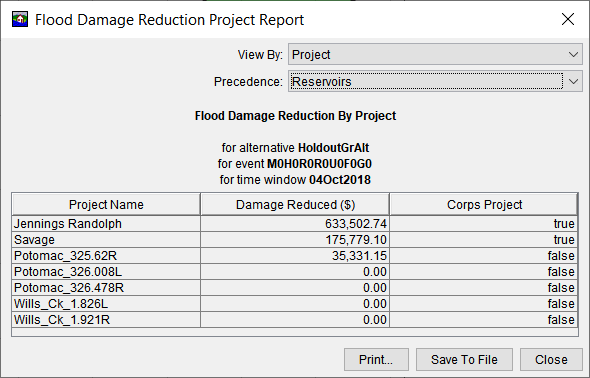Methodology
Introduction
The HEC-FIA flood damages reduced compute ingests the output of a hydraulic model (in this case, HEC-RAS) in the form of either maximum depth grids or DSS time series of stages at cross-sections and storage areas. These results should represent the regulated and unregulated inundations. Then HEC-FIA computes damages throughout the study by running four separate simulations:
- Regulated: uses regulated HEC-RAS stages; computes damages for observed condition
- Unregulated: uses unregulated HEC-RAS stages; computes damages for without reservoirs condition
- Regulated Without Levee: computes damages for a with reservoir, without levee condition
- Unregulated Without Levee: computes damages for a without reservoir, without levee condition
The first two damage computes are based on standard HEC-FIA computational logic using only the HEC-RAS results. The third and fourth are specialized computes attempting to estimate the damages for the event, if the levees were removed from the the study area. This specialized compute uses the adjacent in-channel water surface elevation to compute depths and structure damages within in the levee'd area.
For watersheds with multiple reservoirs HEC-FIA can apportion the total damages reduced to each reservoir based on the influence the reservoir had in reducing downstream flows. To do this, HEC-FIA ingests the Holdouts time series data from HEC-ResSim to proportionally award the damages reduced to each of the reservoirs in the system by comparing the peak holdout flow routed through the system. Another option for apportion damages allows you to specify the percentage of damage to be attributed to each reservoir at specific locations.
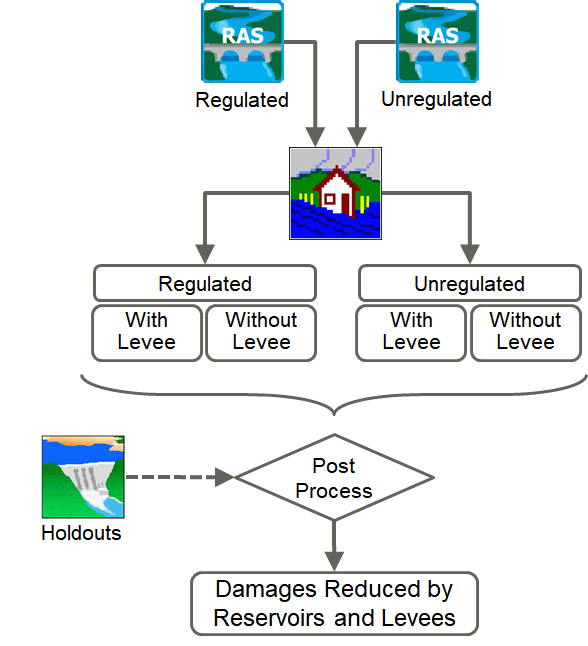
Without Levee Compute
For the without levee compute in HEC-FIA, it is required to import a set of storage areas representing the leveed areas in a study. For all storage areas that represent levees, you must designate them as such and optionally designate what stream alignment segment the structures in the storage area should use to query in-channel depths. For all storage areas that are designated as leveed areas, HEC-FIA uses the river reach attribute to assign a stream stationing to each structure within the storage area. Then damages are computed for the structure based on the in-channel water surface elevation (WSEL) at the station assigned to the structure to simulate the without levee condition. The figure below illustrates how structures in leveed areas query water surface elevations from the stream alignment to compute damages for the without levee scenario.
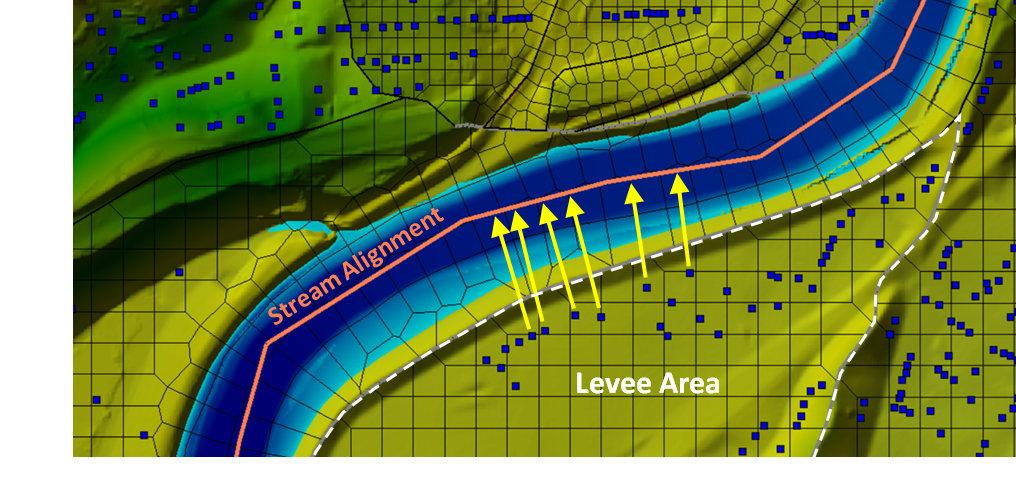
Note there is an underlying assumption with this method that the in-channel water surface elevation is not greatly influenced by the presence or absence of the levee. This assumption simplifies the hydraulic modeling effort by not requiring additional HEC-RAS geometries and modified terrains to account for the change in hydraulics for the without levee condition. However, the simplification can make this method not suitable for watersheds that have large leveed areas with significant storage because water surface elevations in the channel would likely be reduced in the absence of the levee.
Allocating Damages to Reservoirs
The Flood Damage Reduction Project Report displays the damages reduced by each reservoir and levee project in the model domain. If the study contains multiple reservoirs, the question arises of how to allocate the downstream damages back to each of them.
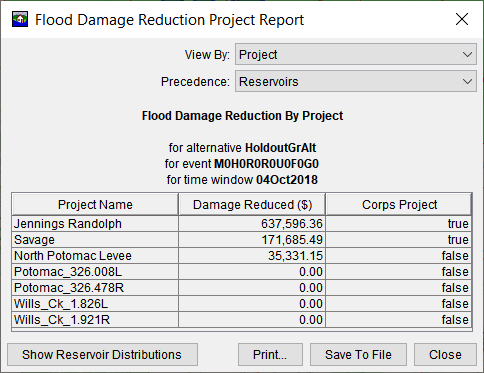
HEC-FIA provides two different option to allocate damages to multiple reservoirs. The first option will apportion the damages for structures within Holdout Areas (HOAs) based on the Holdouts time series computed by HEC-ResSim. The second option allows you tp specify the percentage of damages reduced given to each reservoir for each HOA.
Allocating Damages Using Holdouts Time Series
The HEC-ResSim Holdouts are simply a time series of flow data that is stored (or held out) by each reservoir. The holdout flows are routed downstream and the resulting flow hydrographs are computed at Common Computation Point (CCP).
Holdout Areas (HOAs) are a polygon shapefile – created from the HEC-RAS model extents and delineated based on gage locations – to break up the study area of the HEC-FIA model into smaller pieces. The purpose of the HOAs shapefile is to define how damages are apportioned to reservoirs for all the structures that lie within an HOA. This is done by associating a CCP to the HOA – this allows damages reduced for the structures to be allocated to reservoirs based on the holdout results at the CCP.
A depiction of this is shown in the figure below, damages reduced for structures within HOA 1 will be awarded to Reservoir A based on the holdouts at CCP 1. Damages reduced for Structure in HOA 2 will be awarded to both reservoirs based on their percentages of the total holdouts at CCP 2. In this case, 100% of the damages reduced for structures in HOA 1 will be awarded to Reservoir A; only 33% will be awarded to reservoir A for structures in HOA 2.
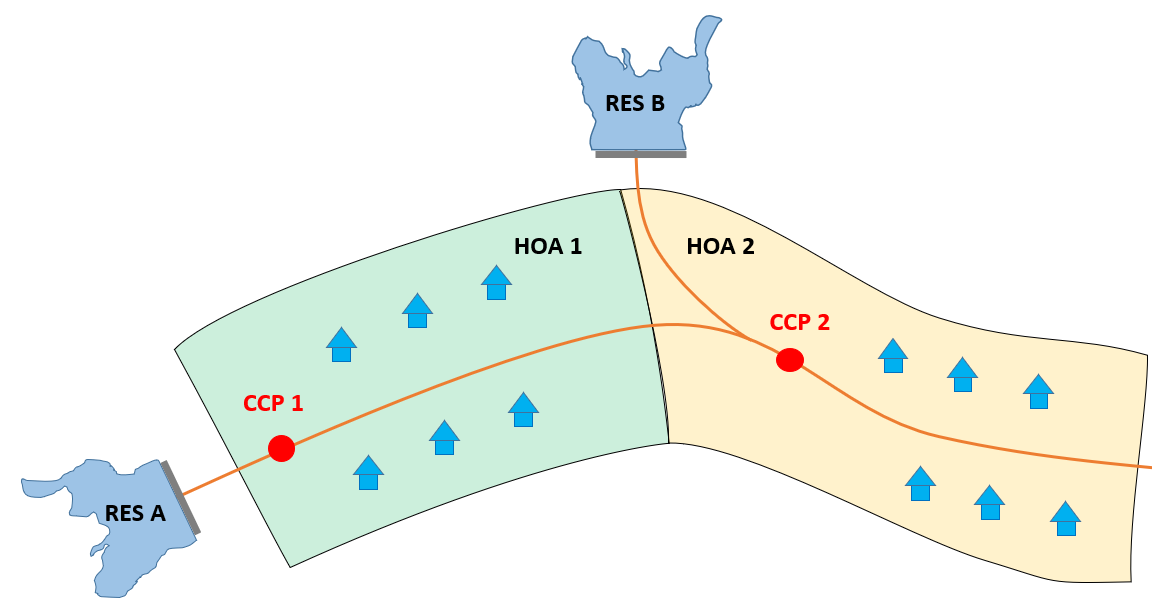

You can view the results of this calculation – the percent of damages allocated to each reservoir – by opening the Reservoir Allocation Table from the Flood Damage Reduction Project Report.
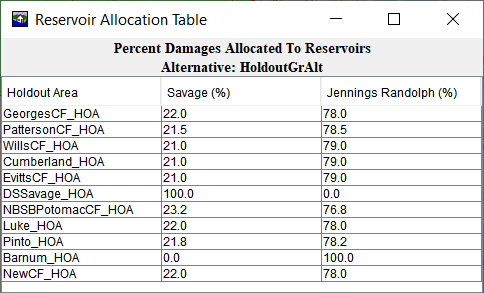
Allocating Damages Using Overrides
Instead of using the holdout time series for allocating damages to reservoirs, a holdout distribution table can be populated in the Alternative Editor to specify the percentage of damages reduced awarded to each reservoir. This allows the distributions to be calculated outside of the forecast using any method you please. The figure below shows the holdout distributions table override in the Alternative Editor with percentages for a two reservoir system:
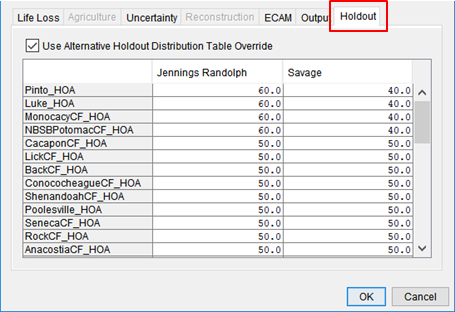
HEC-FIA Damages Reduced Results
Flood damage reduced results can be viewed in one of two reports in HEC-FIA. The Flood Damages Reduced Aggregated Report shows the damage results for each of the four HEC-FIA computes. This report also shows the total damages reduced due to all reservoirs and levees, by comparing the results of the four individual damage computes. Splitting the total damages reduced between levees and reservoirs creates a dilemma because protection within a leveed area can be influenced by both the levee and the reservoir regulation. There are multiple methods to split damage results among reservoirs and levees, and HEC-FIA currently only supports one of these methods in the reports – giving precedence to one or the other, commonly known as first-in-place.
In the example below, for each Holdout Distribution Area the first four columns are simply the total damage results of the four HEC-FIA computes. The next three columns are computed by comparing the results of the first four.
How these results are computed depends on the selection of precedence between reservoirs or levees. In the report, hover over the damages reduced column headers to see how they are computed. A summary of that is shown in the table below.
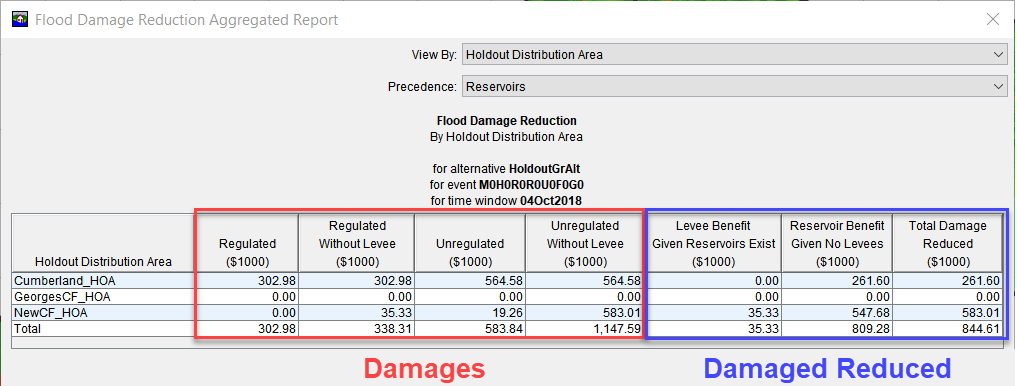
| Result | Equation | Precedence |
|---|---|---|
| Levee Benefit Given Reservoirs Exits | =REG WOL - REG | Reservoirs |
| Reservoir Benefit Given No Levees | =UNREG WOL - REG WOL | Reservoirs |
| Levee Benefit Given No Reservoirs | = UNREG WOL - UNREG | Levees |
| Reservoir Benefit Given Levees Exist | = UNREG - REG | Levees |
| Total Damage Reduced | =UNREG WOL - REG | None |
The second report type available in HEC-FIA is the Flood Damage Reduction Project Report. Its purpose is to display damages reduced by the individual levees and reservoirs in the system. Similar to the aggregate report, there is an option to change precedence between reservoirs and levees. This table uses the methods described above to allocate damages to individual reservoirs based on flow holdouts or an override.
